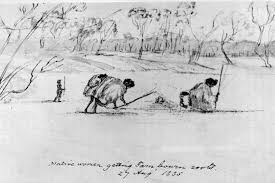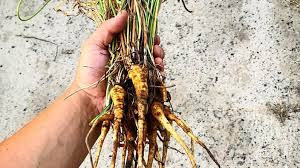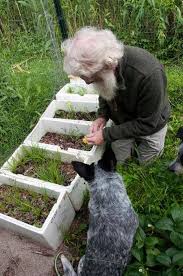Where are the Coconuts?
Mr Pascoe doesn’t seem to mention at all in his Dark Emu book, the cultivation of the coconut, that staple of early agriculturalists all throughout Asia and the Pacific. He does sing the praises of the little Yam daisy, the murnong, the traditional Aboriginal food source of his Aboriginal ‘farmers’ with its ‘coconut’ flavour (Ref 1), but no actual mention of cultivating real coconuts.
This got us thinking; why get your ‘coconut flavour-fix’ from a yam when you could just as easily have the real thing, coconuts? So, if the Aborigines were really “agriculturalists”, as Mr Pascoe claims, and not hunter gatherers, why didn’t they plant and cultivate coconut palms in the north and then trade them across the country via the known, Aboriginal “trading pathways”?
The distribution of the coconut palm was such that conditions were right for it to grow all along the NW to NE coasts of Australia (See map below).
Current Distribution of the Coconut Palm within Red Borders.
Ref 1- SBS FOOD PROGRAM
The Torres Strait Islanders certainly did plant and cultivate coconuts, but why not their cousins, the Australian Aborigines?
- An island in the Torres Strait in 1931 showing local coconut plantations.
Dr Josephine Flood has written about this in her book, The Original Australians :
“The absence of coconut trees in Australia puzzled Cook. Neither he, nor Flinders saw a single one [on their travels up the east and north coasts of Australia]. Why, they wondered, were coconut trees absent from Australia, but flourishing on the coasts of the Torres Strait Islands and the Pacific islands? …coconut seeds [do] arrive fairly frequently on the east coast of Australia. The Aboriginal languages of northeast Queensland had names for the coconut and coconut fruits were traded between Torres Strait Islanders and Cape York Aborigines, yet no coconut palms grew in inhabited pre-colonial Australia. Why not?”
Dr Flood concludes that, “Hungry [Aboriginal] foragers consumed the nuts [that] washed up on the beaches, thankful for the ease of collecting this nutritious, tasty food…A seedling also yields a quick meal for a human…from its residual kernel and spongy ‘apple’ but is destroyed in the process …Even mature trees died after Aborigines harvested the succulent growing bud or ‘heart of palm’.”
Flood, J., “The Original Australians – The Story of the Aboriginal People”, Allen & Unwin, 2nd Ed 2019, p32-33
Coconut seeding taking hold, even in the harsh Hawaiian volcanic sand
Dr Flood finishes by quoting Australian coconut expert, Mike Foale, “but for the presence of Aboriginal hunter gatherers and the foraging white-tailed rat, the coconut would have been well established on at least the most favourable shores of the Australian northeast before European settlement.”
So, no Aboriginal ‘agriculture’ or ‘horticulture’ to see here.
The Aborigines chose to be ‘gatherers’, and consume all the coconut seeds they encountered in their nomadic, hunter gatherer lifestyle, rather than to become more settled and to plant and cultivate coconut palm groves like their cousins, the Torres Strait Islanders. This is a choice that the Aborigines made for themselves, it is neither right nor wrong, but just an historical fact. What is wrong is for some Southern Intellectuals to appear to speak on behalf of Aborigines collectively and classify their society as something the evidence strongly suggests it was not.
In Dark Emu, Mr Pascoe strongly promotes the qualities and economic potential, in his eyes, of the pretty Yam daisy, or murnong, which was one of the staples of many Aboriginal tribes in pre-colonial times. Mr Pascoe claims it is,
“3-4 times the energy level of…potato. Aboriginal people would have required a smaller volume of tubers to attain the same energy quotient that would have allowed for more efficient storage and transport” (Dark Emu, 2018 reprint, p213).
Mr Pascoe admonishing Australia with his plea,
“Surely we can no longer ignore such a valuable plant or the commercial opportunities it offers.” (Dark Emu, 2018 reprint, p26-7).
Mr Pascoe offers no evidence that the murnong was domesticated by the Aborigines such that it was, and still is, amenable to large scale cultivation. No Australian farmers, with Aboriginal heritage or not, seem to have commercialised the murnong, such that Australian consumers can buy it at their local markets. This is despite there having been lots of promotion of the murnong with “feel-good” talk and books like Dark Emu, and even an annual Murnong Festival for the past 10 years.
In summary, we believe that the evidence suggests Aborigines were merely ‘gathering’ murnong and so we should not be surprised that its use faded away as the Aborigines shifted from a hunter-gather society to a modern Australian society, where potatoes have now become the staple tuber food for all Australian. This is evidenced by the fact that Australian farmers produce over 1M tonnes per year of potatoes in ever increasingly, efficient farms (see Graph below). It seems very unlikely that the cultivation of Yam daisy will ever reach these levels of efficiency, even if it is a “naturally-occurring” yam.
Photo 1 - “Sketch of Native Women getting Tam bourn [Yam daisy] Roots 27 August 1835” - Todd Journal
Photo 2 - A modern day ‘harvest’ of yams.
Photo 3 - Mr Pascoe growing Yam daisy
Note the exponential growth (and hence demand by Australians) in the production of potatoes (in tonnes) by Australian farmers, with no increase in the amount of farmland required – This illustrates real agronomic “productivity”.












